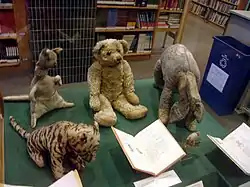Winnie-the-Pooh
Winnie-the-Pooh (also known as Edward Bear, Pooh Bear or simply Pooh) is a fictional anthropomorphic teddy bear created by English author A. A. Milne and English illustrator E. H. Shepard. Winnie-the-Pooh first appeared by name in a children's story commissioned by London's Evening News for Christmas Eve 1925. The character is based on a stuffed toy that Milne had bought for his son Christopher Robin in Harrods department store.[1]
| Winnie-the-Pooh | |
|---|---|
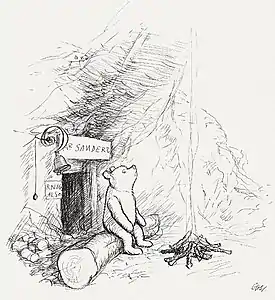 Pooh in an illustration by E. H. Shepard | |
| First appearance |
|
| Created by | |
| Based on | Winnie the bear (name) |
| In-universe information | |
| Nickname |
|
| Species | Teddy Bear |
| Gender | Male |
| Home | Hundred Acre Wood |
The first collection of stories about the character was the book Winnie-the-Pooh (1926), and this was followed by The House at Pooh Corner (1928). Milne also included a poem about the bear in the children's verse book When We Were Very Young (1924) and many more in Now We Are Six (1927). All four volumes were illustrated by E. H. Shepard. The stories are set in Hundred Acre Wood, which was inspired by Five Hundred Acre Wood in Ashdown Forest in East Sussex—situated 30 miles (48 km) south of London—where the Londoner Milne's country home was located.
The Pooh stories have been translated into many languages, including Alexander Lenard's Latin translation, Winnie ille Pu, which was first published in 1958, and, in 1960, became the only Latin book ever to have been featured on The New York Times Best Seller list.[2] The original English manuscripts are held at Wren Library, Trinity College, Cambridge, Milne's alma mater to whom he had bequeathed the works.[3]
In 1961, The Walt Disney Company licensed certain film and other rights of the Winnie-the-Pooh stories from the estate of A. A. Milne and the licensing agent Stephen Slesinger, Inc., and adapted the Pooh stories, using the unhyphenated name "Winnie the Pooh", into a series of features that would eventually become one of its most successful franchises. In popular film adaptations, Pooh has been voiced by actors Sterling Holloway, Hal Smith, and Jim Cummings in English, and Yevgeny Leonov in Russian.
History
Origin
A. A. Milne named the character Winnie-the-Pooh after a teddy bear owned by his son, Christopher Robin Milne, on whom the character Christopher Robin was based. Shepard in turn based his illustrations of Pooh on his own son's teddy bear named Growler, instead of Christopher Robin's bear.[4] The rest of Christopher Milne's toys – Piglet, Eeyore, Kanga, Roo, and Tigger – were incorporated into Milne's stories.[5][6] Two more characters, Owl and Rabbit, were created by Milne's imagination, while Gopher was added to the Disney version. Christopher Robin's toy bear is on display at the Main Branch of the New York Public Library in New York City.[7]
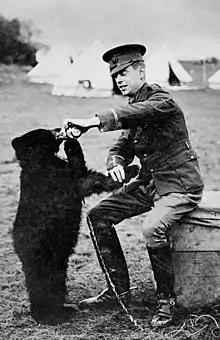
In 1921, Milne bought his son Christopher Robin the toy bear from Harrods department store.[1][8] Christopher Robin had named his toy bear after Winnie, a Canadian black bear he often saw at London Zoo, and Pooh, a friend's pet swan they had encountered while on holiday.[9][10] The bear cub was purchased from a hunter for C$20 by Canadian Lieutenant Harry Colebourn in White River, Ontario, while en route to England during the First World War.[11] Colebourn, a veterinary officer with the Fort Garry Horse cavalry regiment, named the bear Winnie after his adopted hometown in Winnipeg, Manitoba.[12][13] Winnie was surreptitiously brought to England with her owner, and gained unofficial recognition as The Fort Garry Horse regimental mascot. Colebourn left Winnie at the London Zoo while he and his unit were in France; after the war she was officially donated to the zoo, as she had become a much-loved attraction there.[14] Pooh the swan appears as a character in its own right in When We Were Very Young.
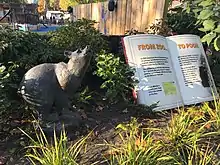
In the first chapter of Winnie-the-Pooh, Milne offers this explanation of why Winnie-the-Pooh is often called simply "Pooh":
But his arms were so stiff ... they stayed up straight in the air for more than a week, and whenever a fly came and settled on his nose he had to blow it off. And I think – but I am not sure – that that is why he is always called Pooh.
American writer William Safire surmised that the Milnes' invention of the name "Winnie the Pooh" may have also been influenced by the haughty character Pooh-Bah in Gilbert and Sullivan's The Mikado (1885).[16]
Ashdown Forest: the setting for the stories
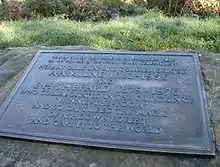
The Winnie-the-Pooh stories are set in Ashdown Forest, East Sussex, England. The forest is an area of tranquil open heathland on the highest sandy ridges of the High Weald Area of Outstanding Natural Beauty situated 30 miles (50 km) south-east of London. In 1925 Milne, a Londoner, bought a country home a mile to the north of the forest at Cotchford Farm, near Hartfield. According to Christopher Robin Milne, while his father continued to live in London "...the four of us – he, his wife, his son and his son's nanny – would pile into a large blue, chauffeur-driven Fiat and travel down every Saturday morning and back again every Monday afternoon. And we would spend a whole glorious month there in the spring and two months in the summer."[17] From the front lawn the family had a view across a meadow to a line of alders that fringed the River Medway, beyond which the ground rose through more trees until finally "above them, in the faraway distance, crowning the view, was a bare hilltop. In the centre of this hilltop was a clump of pines." Most of his father's visits to the forest at that time were, he noted, family expeditions on foot "to make yet another attempt to count the pine trees on Gill's Lap or to search for the marsh gentian". Christopher added that, inspired by Ashdown Forest, his father had made it "the setting for two of his books, finishing the second little over three years after his arrival".[18]
Many locations in the stories can be associated with real places in and around the forest. As Christopher Milne wrote in his autobiography: "Pooh's forest and Ashdown Forest are identical." For example, the fictional "Hundred Acre Wood" was in reality Five Hundred Acre Wood; Galleon's Leap was inspired by the prominent hilltop of Gill's Lap, while a clump of trees just north of Gill's Lap became Christopher Robin's The Enchanted Place, because no-one had ever been able to count whether there were 63 or 64 trees in the circle.[19]
The landscapes depicted in E. H. Shepard's illustrations for the Winnie-the-Pooh books were directly inspired by the distinctive landscape of Ashdown Forest, with its high, open heathlands of heather, gorse, bracken and silver birch, punctuated by hilltop clumps of pine trees. Many of Shepard's illustrations can be matched to actual views, allowing for a degree of artistic licence. Shepard's sketches of pine trees and other forest scenes are held at the Victoria and Albert Museum in London.[20]
The game of Poohsticks was originally played by Christopher Robin Milne and his father on the wooden footbridge,[21] across the Millbrook,[22] Posingford Wood, close to Cotchford Farm. In the stories Pooh plays the game with the other characters, Christopher Robin, Tigger, and Eeyore.[23] The location is now a tourist attraction, and it has become traditional to play the game there using sticks gathered in the nearby woodland.[21][24] When the footbridge had to be replaced in 1999, the architect used as a main source drawings by Shepard in the books, and retained its precursor's original style.[25]
First publication
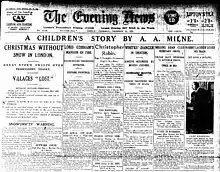
Christopher Robin's teddy bear made his character début, under the name Edward, in A. A. Milne's poem, "Teddy Bear", in the edition of 13 February 1924 of Punch (E. H. Shepard had also included a similar bear in a cartoon published in Punch the previous week[26]), and the same poem was published in Milne's book of children's verse When We Were Very Young (6 November 1924).[27] Winnie-the-Pooh first appeared by name on 24 December 1925, in a Christmas story commissioned and published by the London newspaper Evening News. It was illustrated by J. H. Dowd.[28]
The first collection of Pooh stories appeared in the book Winnie-the-Pooh. The Evening News Christmas story reappeared as the first chapter of the book. At the beginning, it explained that Pooh was in fact Christopher Robin's Edward Bear, who had been renamed by the boy. He was renamed after an American black bear at London Zoo called Winnie who got her name from the fact that her owner had come from Winnipeg, Canada. The book was published in October 1926 by the publisher of Milne's earlier children's work, Methuen, in England, E. P. Dutton in the United States, and McClelland & Stewart in Canada.[29] The book was an immediate critical and commercial success.[30] The children's author and literary critic John Rowe Townsend described Winnie-the-Pooh and its sequel The House at Pooh Corner as "the spectacular British success of the 1920s" and praised its light, readable prose.[31]
Appearance
The original drawing of Pooh was based not on Christopher Robin's bear, but on Growler, the teddy bear belonging to Shepard's son Graham, according to James Campbell, husband of Shepard's great-granddaughter. When Campbell took over Shepard's estate in 2010, he discovered many drawings and unpublished writings, including early drawings of Pooh, that had not been seen in decades. Campbell said, "Both he and A. A. Milne realised that Christopher Robin's bear was too gruff-looking, not very cuddly, so they decided they would have to have a different bear for the illustrations."[32] Campbell said Shepard sent Milne a drawing of his son's bear and that Milne "said it was perfect". Campbell also said Shepard's drawings of Christopher Robin were based partly on his own son.[32]
Character
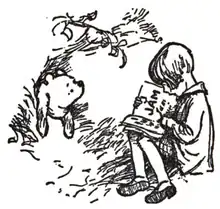
In the Milne books, Pooh is naive and slow-witted, but he is also friendly, thoughtful, and steadfast. Although he and his friends agree that he is "a bear of very little brain", Pooh is occasionally acknowledged to have a clever idea, usually driven by common sense. These include riding in Christopher Robin's umbrella to rescue Piglet from a flood, discovering "the North Pole" by picking it up to help fish Roo out of the river, inventing the game of Poohsticks, and getting Eeyore out of the river by dropping a large rock on one side of him to wash him towards the bank.
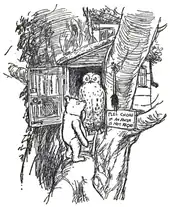
Pooh is also a talented poet and the stories are frequently punctuated by his poems and "hums". Although he is humble about his slow-wittedness, he is comfortable with his creative gifts. When Owl's house blows down in a windstorm, trapping Pooh, Piglet and Owl inside, Pooh encourages Piglet (the only one small enough to do so) to escape and rescue them all by promising that "a respectful Pooh song" will be written about Piglet's feat. Later, Pooh muses about the creative process as he composes the song.
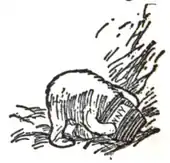
Pooh is very fond of food, particularly honey (which he spells "hunny"), but also condensed milk and other items. When he visits friends, his desire to be offered a snack is in conflict with the impoliteness of asking too directly. Though intent on giving Eeyore a pot of honey for his birthday, Pooh could not resist eating it on his way to deliver the present and so instead gives Eeyore "a useful pot to put things in". When he and Piglet are lost in the forest during Rabbit's attempt to "unbounce" Tigger, Pooh finds his way home by following the "call" of the honeypots from his house. Pooh makes it a habit to have "a little something" around 11:00 in the morning. As the clock in his house "stopped at five minutes to eleven some weeks ago", any time can be Pooh's snack time.
Pooh is very social. After Christopher Robin, his closest friend is Piglet, and he most often chooses to spend his time with one or both of them. But he also habitually visits the other animals, often looking for a snack or an audience for his poetry as much as for companionship. His kind-heartedness means he goes out of his way to be friendly to Eeyore, visiting him and bringing him a birthday present and building him a house, despite receiving mostly disdain from Eeyore in return. Devan Coggan of Entertainment Weekly saw a similarity between Pooh and Paddington Bear, two "extremely polite British bears without pants", adding that "both bears share a philosophy of kindness and integrity".[33]
Posthumous sequels
An authorised sequel Return to the Hundred Acre Wood was published on 5 October 2009. The author, David Benedictus, has developed, but not changed, Milne's characterisations. The illustrations, by Mark Burgess, are in the style of Shepard.[34]
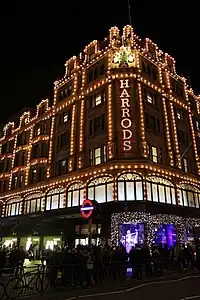
Another authorised sequel, Winnie-the-Pooh: The Best Bear in All the World, was published by Egmont in 2016. The sequel consists of four short stories by four leading children's authors, Kate Saunders, Brian Sibley, Paul Bright, and Jeanne Willis. Illustrations are by Mark Burgess.[35] The Best Bear in All The World sees the introduction of a new character, Penguin, which was inspired by a long-lost photograph of Milne and his son Christopher with a toy penguin.[36][37]
In 2016, Winnie-the-Pooh Meets the Queen was published to mark the 90th anniversary of Milne's creation and the 90th birthday of Queen Elizabeth II. It sees Pooh meet the Queen at Buckingham Palace.[38]
In 2021, marking a century since Milne bought the stuffed toy from Harrods department store for his son Christopher Robin that would inspire Milne to create the character, Winnie-the-Pooh: Once There Was a Bear, the first prequel to Milne's books and poetry about the bear, was authorised by the estates of Milne and Shepard.[1] Inspired by the real life of Christopher Robin, it is written by children's writer Jane Riordan in the style of Milne, with illustrations by Mark Burgess emulating the drawings of Shepard.[1] It sees Winnie-the-Pooh exploring Harrods as well as visit London's Natural History Museum and London Zoo, before leaving London and going back to the Hundred Acre Wood.[1]
Stephen Slesinger
On 6 January 1930, Stephen Slesinger purchased US and Canadian merchandising, television, recording, and other trade rights to the Winnie-the-Pooh works from Milne for a $1,000 advance and 66% of Slesinger's income.[39] By November 1931, Pooh was a $50 million-a-year business.[40] Slesinger marketed Pooh and his friends for more than 30 years, creating the first Pooh doll, record, board game, puzzle, US radio broadcast (on NBC), animation, and motion picture.[41]
Red shirt Pooh
The first time Pooh and his friends appeared in colour was 1932, when he was drawn by Slesinger in his now-familiar red shirt and featured on an RCA Victor picture record. Parker Brothers introduced A. A. Milne's Winnie-the-Pooh Game in 1933, again with Pooh in his red shirt. In the 1940s, Agnes Brush created the first plush dolls with Pooh in a shirt.[42][43]
Disney exclusivity (1953–2021)
After Slesinger's death in 1953, his wife, Shirley Slesinger Lasswell, continued developing the character herself. In 1961, she licensed rights to Walt Disney Productions in exchange for royalties in the first of two agreements between Stephen Slesinger, Inc., and Disney.[44] The same year, A. A. Milne's widow, Daphne Milne, also licensed certain rights, including motion picture rights, to Disney.
Since 1966, Disney has released numerous animated productions starring its version of Winnie the Pooh and related characters, starting with the theatrical featurette Winnie the Pooh and the Honey Tree. This was followed by Winnie the Pooh and the Blustery Day (1968), and Winnie the Pooh and Tigger Too (1974). These three featurettes were combined into a feature-length film, The Many Adventures of Winnie the Pooh, in 1977. A fourth featurette, Winnie the Pooh and a Day for Eeyore, was released in 1983.
A new series of Winnie the Pooh theatrical feature-length films launched in the 2000s, with The Tigger Movie (2000), Piglet's Big Movie (2003), Pooh's Heffalump Movie (2005), and Winnie the Pooh (2011).
Disney has also produced television series based on the franchise, including Welcome to Pooh Corner (Disney Channel, 1983–1986), The New Adventures of Winnie the Pooh (ABC, 1988–1991), The Book of Pooh (Playhouse Disney, 2001–2003), and My Friends Tigger & Pooh (Playhouse Disney, 2007–2010).
A. A. Milne's U.S. copyright in the Winnie-the-Pooh character expired at the end of 2021, as it had been 95 years since publication of the first story. The character has thus entered the public domain in the United States and Disney no longer holds exclusive rights there. Independent filmmaker Rhys Frake-Waterfield capitalized on this shortly thereafter by producing a horror film titled Winnie-the-Pooh: Blood and Honey.[45] The UK copyright will expire on 1 January 2027, the 70th year since Milne's death.[46]
Playdate with Winnie the Pooh, an animated series of musical shorts by OddBot Inc. for Disney Junior, became the first project from Disney to be released after the original book and characters became public domain.[47][48][49][50]
Merchandising revenue dispute
Pooh videos, soft toys, and other merchandise generate substantial annual revenues for Disney. The size of Pooh stuffed toys ranges from Beanie and miniature to human-sized. In addition to the stylised Disney Pooh, Disney markets Classic Pooh merchandise which more closely resembles E. H. Shepard's illustrations.
In 1991, Stephen Slesinger, Inc., filed a lawsuit against Disney which alleged that Disney had breached their 1983 agreement by again failing to accurately report revenue from Winnie the Pooh sales. Under this agreement, Disney was to retain approximately 98% of gross worldwide revenues while the remaining 2% was to be paid to Slesinger. In addition, the suit alleged that Disney had failed to pay required royalties on all commercial exploitation of the product name.[51] Though the Disney corporation was sanctioned by a judge for destroying forty boxes of evidentiary documents,[52] the suit was later terminated by another judge when it was discovered that Slesinger's investigator had rummaged through Disney's garbage to retrieve the discarded evidence.[53] Slesinger appealed the termination and, on 26 September 2007, a three-judge panel upheld the lawsuit dismissal.[54]
After the Copyright Term Extension Act of 1998, Clare Milne, Christopher Robin Milne's daughter, attempted to terminate any future US copyrights for Stephen Slesinger, Inc.[55] After a series of legal hearings, Judge Florence-Marie Cooper of the US District Court in California found in favour of Stephen Slesinger, Inc., as did the United States Court of Appeals for the Ninth Circuit. On 26 June 2006, the US Supreme Court refused to hear the case, sustaining the ruling and ensuring the defeat of the suit.[56]
On 19 February 2007, Disney lost a court case in Los Angeles which ruled their "misguided claims" to dispute the licensing agreements with Slesinger, Inc., were unjustified,[57] but a federal ruling of 28 September 2009, again from Judge Florence-Marie Cooper, determined that the Slesinger family had granted all trademarks and copyrights to Disney, although Disney must pay royalties for all future use of the characters. Both parties expressed satisfaction with the outcome.[58][59]
Other adaptations
Literature
- 2022. The Call of Poohthulhu, an anthology of Lovecraftian horror short stories set in the Winnie-the-Pooh universe[60]
Theatre
- 1931. Winnie-the-Pooh at the Guild Theater, Sue Hastings Marionettes[61]
- 1957. Winnie-the-Pooh, a play in three acts, dramatized by Kristin Sergel, Dramatic Publishing Company
- 1964. Winnie-the-Pooh, a musical comedy in two acts, lyrics by A. A. Milne and Kristin Sergel, music by Allan Jay Friedman, book by Kristin Sergel, Dramatic Publishing Company
- 1977. A Winnie-the-Pooh Christmas Tail, in which Winnie-the-Pooh and his friends help Eeyore have a very Merry Christmas (or a very happy birthday), with the book, music, and lyrics by James W. Rogers, Dramatic Publishing Company[62]
- 1986. Bother! The Brain of Pooh, Peter Dennis
- 1992. Winnie-the-Pooh, small cast musical version, dramatized by le Clanché du Rand, music by Allan Jay Friedman, lyrics by A. A. Milne and Kristin Sergel, additional lyrics by le Clanché du Rand, Dramatic Publishing Company
- 2021. Winnie the Pooh: The New Musical Adaptation[63]
Audio
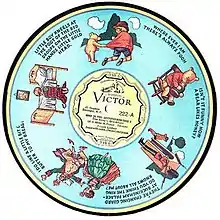
Selected Pooh stories read by Maurice Evans released on vinyl LP:
- 1956. Winnie-the-Pooh (consisting of three tracks: "Introducing Winnie-the-Pooh and Christopher Robin"; "Pooh Goes Visiting and Gets into a Tight Place"; and "Pooh and Piglet Go Hunting and Nearly Catch a Woozle")
- More Winnie-the-Pooh (consisting of three tracks: "Eeyore Loses a Tail"; "Piglet Meets a Heffalump"; "Eeyore Has a Birthday")
In 1951, RCA Records released four stories of Winnie-the-Pooh, narrated by Jimmy Stewart and featuring the voices of Cecil Roy as Pooh, Madeleine Pierce as Piglet, Betty Jane Tyler as Kanga, Merrill Joels as Eeyore, Arnold Stang as Rabbit, Frank Milano as Owl, and Sandy Fussell as Christopher Robin.[64]
In 1960, HMV recorded a dramatised version with songs (music by Harold Fraser-Simson) of two episodes from The House at Pooh Corner (Chapters 2 and 8), starring Ian Carmichael as Pooh, Denise Bryer as Christopher Robin (who also narrated), Hugh Lloyd as Tigger, Penny Morrell as Piglet, and Terry Norris as Eeyore. This was released on a 45 rpm EP.[65]
In the 1970s and 1980s, Carol Channing recorded Winnie the Pooh, The House at Pooh Corner and The Winnie the Pooh Songbook, with music by Don Heckman. These were released on vinyl LP and audio cassette by Caedmon Records.
Unabridged recordings read by Peter Dennis of the four Pooh books:
- When We Were Very Young
- Winnie-the-Pooh
- Now We Are Six
- The House at Pooh Corner
In 1979, a double audio cassette set of Winnie the Pooh was produced featuring British actor Lionel Jeffries reading all of the characters in the stories. This was followed in 1981 by an audio cassette set of stories from The House at Pooh Corner also read by Lionel Jeffries.[66]
In the 1990s, the stories were dramatised for audio by David Benedictus, with music composed, directed and played by John Gould. They were performed by a cast that included Stephen Fry as Winnie-the-Pooh, Jane Horrocks as Piglet, Geoffrey Palmer as Eeyore, Judi Dench as Kanga, Finty Williams as Roo, Robert Daws as Rabbit, Michael Williams as Owl, Steven Webb as Christopher Robin and Sandi Toksvig as Tigger.[67]
Radio
- The BBC included readings of Winnie-the-Pooh stories in its programmes for children very soon after their first publication. One of the earliest of such readings, by "Uncle Peter" (C. E. Hodges), was an item in the programme For the Children, broadcast by stations 2LO and 5XX on 23 March 1926. Norman Shelley was the notable voice of Pooh on the BBC's Children's Hour.[68]
- Pooh made his US radio debut on 10 November 1932, when he was broadcast to 40,000 schools by The American School of the Air, the educational division of the Columbia Broadcasting System.[69]
Film
- 2017: Goodbye Christopher Robin, a British drama film exploring the creation of Winnie-the-Pooh with Domhnall Gleeson playing A. A. Milne.[70]
- 2018: Christopher Robin, an extension of the Disney Winnie the Pooh franchise, Ewan McGregor plays Christopher Robin, and filming took place at Ashdown Forest.[71]
- 2023: Winnie-the-Pooh: Blood and Honey, a horror adaptation depicting both Winnie-the-Pooh and Piglet as homicidal maniacs who go on a killing spree after Christopher Robin abandons them.[72]
- 2024: Untitled animated prequel.[73]
Soviet adaptation
.jpg.webp)
In the Soviet Union, three Winnie-the-Pooh, (transcribed in Russian as Винни-Пух, Vinni Pukh) stories were made into a celebrated trilogy.[74]
- 1969. Winnie-the-Pooh (Винни-Пух) – based on chapter 1
- 1971. Winnie-the-Pooh Pays a Visit (Винни-Пух идёт в гости) – based on chapter 2
- 1972. Winnie-the-Pooh and a Busy Day (Винни-Пух и день забот) – based on chapters 4 and 6.
The films used Boris Zakhoder's translation of the book. Pooh was voiced by Yevgeny Leonov. Unlike in the Disney adaptations, the animators did not base their depictions of the characters on Shepard's illustrations, instead creating a different look. The Soviet adaptations made extensive use of Milne's original text and often brought out aspects of Milne's characters' personalities not used in the Disney adaptations.
Television
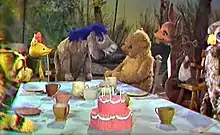
- 1960: Shirley Temple's Storybook on NBC: Winnie-the-Pooh—a version for marionettes, designed, made, and operated by Bil and Cora Baird. Pooh was voiced by future Muppet performer Faz Fazakas.
- During the 1970s, the BBC children's television show Jackanory serialised the two books, which were read by Willie Rushton.[75]
- 2024: Untitled animated series.[73]
- TBA: Christopher Robin (Working Title). R-rated live action/hybrid series featuring a middle age drugged Christopher Robin travelling back to the One Hundred Acre Wood.[76]
Advertisement
- 2022: "Winnie-the-Screwed", an advertisement made by Ryan Reynolds for Mint Mobile.[77]
Games
- 2023: "Winnie's Hole", an upcoming indie rogue-lite body horror video game by Australian studio Twice Different.[78][79][80]
Cultural legacy
Maev Kennedy of The Guardian called Winnie-the-Pooh "the most famous bear in literary history".[81] One of the best-known characters in British children's literature, a 2011 poll saw the bear voted onto the list of top 100 "icons of England".[82] In 2003 the first Pooh story was ranked number 7 on the BBC's The Big Read poll.[83] Forbes magazine ranked Pooh the most valuable fictional character in 2002, with merchandising products alone generating more than $5.9 billion that year.[84] In 2005, Pooh generated $6 billion, a figure surpassed by only Mickey Mouse.[85] In 2006, Pooh received a star on the Hollywood Walk of Fame, marking the 80th birthday of Milne's creation.[85] In 2010, E. H. Shepard's original illustrations of Winnie the Pooh (and other Pooh characters) featured on a series of UK postage stamps issued by the Royal Mail.[86]
.jpg.webp)
Winnie the Pooh has inspired multiple texts to explain complex philosophical ideas. Benjamin Hoff uses Milne's characters in The Tao of Pooh and The Te of Piglet to explain Taoism. Similarly, Frederick Crews wrote essays about the Pooh books in abstruse academic jargon in The Pooh Perplex and Postmodern Pooh to satirise a range of philosophical approaches.[87] Pooh and the Philosophers by John T. Williams uses Winnie the Pooh as a backdrop to illustrate the works of philosophers, including Descartes, Kant, Plato and Nietzsche.[88] "Epic Pooh" is a 1978 essay by Michael Moorcock that compares much fantasy writing to A. A. Milne's, as work intended to comfort, not challenge.
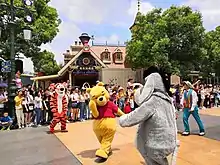
In music, Kenny Loggins wrote the song "House at Pooh Corner", which was originally recorded by the Nitty Gritty Dirt Band.[89] Loggins later rewrote the song as "Return to Pooh Corner", featuring on the album of the same name in 1991. In Italy, a pop band took their name from Winnie, and were titled Pooh. In Estonia, there is a punk/metal band called Winny Puhh. There is a street in Warsaw, Poland, named after the character, the Kubusia Puchatka Street, as he is known in Polish translations as Kubuś Puchatek.[90] There is also a street named after him in Budapest, Hungary, the Micimackó Street.[91]
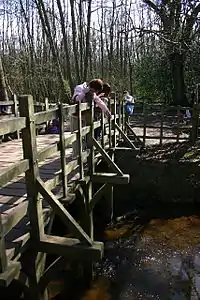
In the "sport" of Poohsticks, competitors drop sticks into a stream from a bridge and then wait to see whose stick will cross the finish line first. Competitors hold their sticks at arms length at the same height, then drop their sticks into the water at the same time.[92] Though it began as a game played by Pooh and his friends in the book The House at Pooh Corner and later in the films, it has crossed over into the real world: a World Championship Poohsticks race takes place in Oxfordshire each year. Ashdown Forest in south east England, where the Pooh stories are set, is a popular tourist attraction, and includes the wooden Pooh Bridge where Pooh and Piglet invented Poohsticks.[93] The Oxford University Winnie the Pooh Society was founded by undergraduates in 1982.[94]
From December 2017 to April 2018, the Victoria and Albert Museum in London hosted the exhibition Winnie-the-Pooh: Exploring a Classic.[95] On exhibit were A. A. Milne's manuscript of Winnie-the-Pooh and The House at Pooh Corner (on loan from the Wren Library at Trinity College, Cambridge, Milne's alma mater to whom he had bequeathed the works), and teddy bears that had not been on display for some 40 years because they were so fragile.[81][96]
In 2018, E. H. Shepard's original 1926 illustrated map of the Hundred Acre Wood, which features in the opening pages of Milne's books and also appears in the opening animation in the first Disney adaptation in 1966, sold for £430,000 ($600,000) at Sotheby's in London, setting a world record for book illustrations.[97][98]
The Japanese figure skater and two-time Olympic champion Yuzuru Hanyu regards Pooh as his lucky charm.[99] He is usually seen with a stuffed Winnie-the-Pooh during his figure skating competitions. Because of this, Hanyu's fans will throw stuffed Winnie-the-Poohs onto the ice after his performance.[100] After one of Hanyu's performances at the 2018 Winter Olympics in Pyeongchang, one spectator remarked that "the ice turned yellow" because of all the Poohs thrown onto the ice.[101]
Comparison to Xi Jinping

In China, images of Pooh were censored from social media websites in mid-2017, when Internet memes comparing Chinese Paramount Leader and General Secretary of the Communist Party Xi Jinping to (Disney's version of) Pooh became popular.[102] The 2018 film Christopher Robin was also denied a Chinese release.[103]
When Xi visited the Philippines, protestors posted images of Pooh on social media.[104] Other politicians have been compared to Winnie-the-Pooh characters alongside Xi, including Barack Obama as Tigger, Carrie Lam, Rodrigo Duterte,[105] and Peng Liyuan as Piglet,[106] and Fernando Chui and Shinzo Abe as Eeyore.[107]
Pooh's Chinese name (Chinese: 小熊维尼; lit. 'little bear Winnie') has been censored from video games such as World of Warcraft, PlayerUnknown's Battlegrounds, Arena of Valor,[108] and Devotion.[109] Images of Pooh in Kingdom Hearts III were also blurred out on the gaming site A9VG.[110]
Despite the ban, two Pooh-themed rides still operate in Disneyland Shanghai, and it is also legal to purchase Pooh-bear merchandise and books about Winnie the Pooh in China.[111][112] In May 2021, a performer dressed up as Winnie-the-Pooh in Shanghai Disneyland was beaten by a child tourist. Mass media in China used the term "Pooh Pooh Bear" (Chinese: 噗噗熊) in reports about this incident because the word "Winnie" has been censored. However, search results of "Pooh Pooh Bear hurt in Shanghai Disneyland" were censored on Weibo after this incident happened.[113][114]
In October 2019, Pooh was featured in the South Park episode "Band in China" as a prisoner in China because of his alleged resemblance with Xi. In the episode, Pooh is brutally killed by Randy Marsh. South Park was banned in China as a result of the episode.[115][116]
Taiwanese pilots have worn morale patches which feature a formosan black bear punching Winnie-the-Pooh in the face.[117] The patches are produced by a private company and demand for them surged greatly after pictures of active duty personal wearing them began circulating.[118][119]
References
- "Winnie-the-Pooh goes to Harrods in new authorised AA Milne prequel". The Guardian. Retrieved 23 April 2023.
The story of how Winnie-the-Pooh went from a Harrods toy shelf to the home of Christopher Robin and the Hundred Acre Wood is set to be told for the first time, in an official prequel to AA Milne's original stories.
- McDowell, Edwin. "Winnie ille Pu Nearly XXV Years Later", The New York Times (18 November 1984). Retrieved 2 January 2010.
- "A A Milne's Winnie-the-Pooh goes to London". Trinity College Cambridge. Retrieved 23 April 2023.
- "Public Domain Day 2022 Brand Culture vs the Public Domain | Duke University School of Law". web.law.duke.edu.
- "Pooh celebrates his 80th birthday"
- "Happy Birthday Pooh"
- "The Adventures of the Real Winnie-the-Pooh.
- "'Winnie the Pooh has an enchanting heritage'". Licensing source. Retrieved 16 June 2022.
- "The real-life Canadian story of Winnie-the-Pooh". CBC Kids. 17 January 2022. Retrieved 20 December 2022.
- "How Winnie-the-Pooh Got His Name". Time. Retrieved 20 December 2022.
- "Winnie the Pooh's Canadian beginnings". The Hamilton Spectator. Hamilton, Ontario. 2 August 1997. p. W.13. Archived from the original on 22 October 2017. Retrieved 7 July 2017 – via PQArchiver.com.
- Mattick, Lindsay (20 October 2015). Finding Winnie: The True Story of the World's Most Famous Bear. Little, Brown Books for Young Readers. ISBN 978-0-316-38802-3.
- Klein, Christopher. "The True Story of the Real-Life Winnie-the-Pooh". HISTORY. Retrieved 20 December 2022.
- "Winnie". Historica Minutes, The Historica Foundation of Canada. Retrieved 30 May 2008.
- "The bear who inspired Winnie-the-Pooh". Zoological Society of London. Retrieved 12 June 2022.
- Safire, William. 1993. "Whence Poo-Bah". GASBAG 24(3) issue 186:28–28.
- Willard, Barbara (1989). The Forest – Ashdown in East Sussex. Sussex: Sweethaws Press.. Quoted from the Introduction, p. xi, by Christopher Milne.
- Willard (1989). Quoted from the Introduction, p. xi, by Christopher Milne.
- Hope, Yvonne Jefferey (2000). "Winnie-the-Pooh in Ashdown Forest". In Brooks, Victoria (ed.). Literary Trips: Following in the Footsteps of Fame. Vol. 1. Vancouver, Canada: Greatest Escapes. p. 287. ISBN 0-9686137-0-5.
- "About the E. H. Shepard archive". Surrey.ac.uk. University of Surrey. Archived from the original on 3 May 2012. Retrieved 1 May 2012.
- "Plans to improve access to Pooh Bridge unveiled". BBC News. Retrieved 11 November 2012.
- Named stream. OpenStreetMap. Retrieved 2019-11-23.
- "New 'pooh-sticks' World Champion". BBC. 16 March 2003. Retrieved 27 April 2023.
- "Appeal to save Winnie the Pooh's bridge". BBC News. Retrieved 11 November 2012.
- Halstead, Robin (21 March 2008). "Great escapes: Days out with a difference". The Independent. London. Retrieved 27 April 2023.
- Davies, Ross E. "An Ursine Foot Note", Re-readings, vol. 5, 2020, p. 2.
- "Celebrate Winnie-The-Pooh's 90th with a Rare Recording (and Hunny)". NPR.org. National Public Radio. 20 July 2015.
- "A Children's Story by A. A. Milne". Evening News. London. 24 December 1925. p. 1.
- Thwaite, Ann (2004). Oxford Dictionary of National Biography: Alan Alexander Milne. Oxford University Press.
- "A Short History of Winnie-the-Pooh". Penguin Group. Archived from the original on 2 November 2015. Retrieved 28 April 2023.
- Townsend, John Rowe (1 May 1996). Written for Children: An Outline of English-Language Children's Literature. Scarecrow Press. pp. 125–126. ISBN 978-1-4617-3104-7.
- Flood, Alison (4 September 2017). "The real Winnie-the-Pooh revealed to have been 'Growler'". The Guardian.
- "Please do not pit Paddington and Pooh against each other". Entertainment Weekly. Retrieved 16 June 2022.
- Kennedy, Maev (4 October 2009). "Pooh sequel returns Christopher Robin to Hundred Acre Wood". The Guardian. p. 15.
- "Winnie-the-Pooh sequel details revealed". Retrieved 18 October 2016.
- "Listen to the moment Winnie-the-Pooh meets penguin friend in new book". BBC News. 19 September 2016.
- The World of Pooh Lives On. Vol. 40. LIFE: Time Inc. 27 February 1956. p. 118.
- "Winnie the Pooh meets the Queen in a new story". BBC News. 19 September 2016.
- Johnson, David. "The 80-Year Struggle For Control Over Winnie The Pooh". Business Insider. Retrieved 28 April 2023.
- "The Merchant of Child". Fortune. November 1931. p. 71.
- McElway, St. Claire (26 October 1936). "The Literary Character in Business & Commerce". The New Yorker.
- Cockrill, Pauline (1991). The Ultimate Teddy Bear Book. Dorling Kindersley. p. 57.
- Pearson, Sue; Ayers, Dottie (1995). Teddy Bears: A Complete Guide to History, Collecting, and Care. Macmillan USA. ISBN 978-0-02-860417-6.
- Leonard, Devin (20 January 2003). "The Curse of Pooh". Fortune. Retrieved 29 April 2018.
- Leonard, Devin (25 May 2022). "Winnie the Pooh: Blood and Honey Images Reveal First Look at Horror Reimagining". ComicBook.com. Retrieved 25 May 2022.
- "Walt Disney secures rights to Winnie the Pooh". The Guardian. London. 6 March 2001. Retrieved 17 June 2022.
- Petski, Denise (29 April 2022). "John Stamos To Voice Iron Man In 'Spidey and His Amazing Friends' Season 2; New Disney Jr. Programming Slate Unveiled". Deadline Hollywood. Retrieved 11 June 2023.
- "Disney Junior Greenlights 'Ariel' Series, Plus 'Magicampers' and 'Playdate With Winnie the Pooh' - WDW News Today". wdwnt.com. 13 June 2023. Retrieved 16 June 2023.
- "First Look At Disney Junior's "Playdate With Winnie the Pooh"". Retrieved 16 June 2023.
- "Disney Previews New Mickey Mouse and Winnie the Pooh Shows". TV Shows. Retrieved 16 June 2023.
- Shea, Joe (18 January 2002). "The Pooh Files". The Albion Monitor. Archived from the original on 5 December 2006.
- Nelson, Valerie J. (20 July 2007). "Shirley Slesinger Lasswell, 84; fought Disney over Pooh royalties". Los Angeles Times. Retrieved 18 January 2019.
- James, Meg (18 January 2002). "Court Rulings Go Against Disney in Pooh Dispute". Los Angeles Times. Retrieved 21 October 2021.
- James, Meg (26 September 2007). "Disney wins lawsuit ruling on Pooh rights". Los Angeles Times. Retrieved 26 September 2007.
- "Winnie the Pooh goes to court". USA Today. 6 November 2002. Archived from the original on 3 November 2012. Retrieved 18 January 2019.
- "Justices won't hear copyright appeal by relative of Winnie the Pooh". USA Today. Associated Press. 26 June 2006. Archived from the original on 5 September 2021. Retrieved 18 January 2019.
- "Disney loses court battle in Winnie the Pooh copyright case". ABC News. 17 February 2007. Archived from the original on 18 May 2008. Retrieved 15 May 2008.
- James, Meg (29 September 2009). "Pooh rights belong to Disney, judge rules". Los Angeles Times. Retrieved 5 October 2009.
- Shea, Joe (4 October 2009). "The gordian knot of Pooh rights is finally untied in federal court". The American Reporter. Retrieved 5 October 2009.
- Cunningham, Lisa; Rawlik, Pete; Morgan, Christine (7 May 2022). The Call of Poohthulhu. Amazon Digital Services LLC - Kdp. ISBN 979-8-4470-9291-7.
- "Hastings Marionettes: Will Open Holiday Season at Guild Theatre on Saturday". The New York Times. 22 December 1931. p. 28.
- Quamme, Margaret. 7 December 2019. "'A Winnie-the-Pooh Christmas Tail:' Delightful production a low-key, amusing hour of fun Archived 13 August 2020 at the Wayback Machine" (review). The Columbus Dispatch.
- Rabinowitz, Chloe. "WINNIE THE POOH: THE NEW MUSICAL ADAPTATION Will Open Off-Broadway This Fall". BroadwayWorld.com.
- "Disney's "Winnie the Pooh" on Records". cartoonresearch.com. Retrieved 23 February 2021.
- "Ian Carmichael and Full Cast – The House at Pooh Corner – HMV Junior Record Club – UK – 7EG 117". 45Cat.com. 23 July 2010. Retrieved 5 November 2011.
- Winnie the Pooh. OCLC 220534420.
- Tigger Comes to the Forest: And Other Stories. OCLC 141191344.
- Ian Hartley, Goodnight children...everywhere Midas Books: Hippocrene Books, New York: 1983; p. 42
- "His Master's Voice Speaks Again". Playthings. November 1932.
- Jaafar, Ali (13 April 2016). "'Star Wars' Domhnall Gleeson in Talks To Play Winnie The Pooh Creator AA Milne In 'Goodbye Christopher Robin'". Deadline Hollywood. Retrieved 12 June 2022.
- Daniels, Nia (9 August 2017). "Disney's Christopher Robin starts filming in the UK". KFTV. Media Business Insight. Retrieved 12 June 2022.
- "'Winnie the Pooh: Blood and Honey' Director Teases Slasher Film Plot: 'Pooh and Piglet Go on a Rampage'". 26 May 2022.
- Ramachandran, Naman (14 December 2022). "'Winnie the Pooh' Origin Story Prequel in the Works at Baboon Animation, IQI". Variety. Retrieved 31 December 2022.
- "Russian animation in letters and figures: 'Winnie the Pooh'". Animator.ru. Retrieved 9 March 2015.
- Biography: Willie Rushton. BBC. Retrieved 11 March 2015.
- Petski, Denise (27 April 2023). "'Christopher Robin' R-Rated Hybrid Comedy Series In The Works". Deadline Hollywood. Retrieved 27 April 2023.
- "Ryan Reynolds uses Winnie the Pooh in mobile ad as character joins public domain". The Independent. 4 January 2022. Retrieved 25 May 2023.
- "Winnie's Hole on Steam". store.steampowered.com. Retrieved 3 October 2023.
- Alexander, Cristina (7 June 2023). "Winnie the Pooh Is Now the Subject of a Bizarre Indie Horror Game". IGN. Retrieved 3 October 2023.
- Winnie's Hole - Game Announcement Trailer, retrieved 3 October 2023
- Kennedy, Maev (3 September 2017). "Winnie-the-Pooh heads to V&A for big winter exhibition". The Guardian. ISSN 0261-3077. Retrieved 4 April 2020.
- "Icons of England: The 100 Icons as voted by the public". Culture 24 News. 20 July 2015.
- "The Big Read", BBC, April 2003. Retrieved 18 October 2012.
- "Top-earning Fictional Characters". Forbes (New York). 25 September 2003. Retrieved 11 November 2012.
- "Pooh joins Hollywood Walk of Fame", BBC News. Retrieved 24 November 2014
- "Winnie the Pooh is celebrated as a fine stamp of a bear". The Times. Retrieved 17 September 2022.
- spiked-culture |Article |Pooh-poohing postmodernism Archived 16 June 2007 at the Wayback Machine. Spiked-online.com. Retrieved 12 February 2011.
- Sonderbooks Book Review of Pooh and the Philosophers. Sonderbooks.com (20 April 2004). Retrieved 12 February 2011.
- "House at Pooh Corner by Loggins and Messina Songfacts". Songfacts.com. 14 October 1926. Retrieved 9 March 2015.
- "Полвека с опилками и ворчалками в голове - Винни-Пух отмечает юбилей" (in Russian). Izvestiya. 13 July 2010. Archived from the original on 20 October 2013. Retrieved 30 July 2016.
- "@47.415006,19.138366,17z". Google Maps. 1 January 1970. Retrieved 9 March 2015.
- "Witney's World Poohsticks Championships mark 35 years". BBC News. 3 June 2018. Retrieved 16 January 2023.
- Plans to improve access to Pooh Bridge unveiled. BBC. Retrieved 15 October 2011
- C.S. Lewis and His Circle: Essays and Memoirs from the Oxford C.S. Lewis Society. Oxford University Press. 2015. p. 249.
- "Winnie-the-Pooh: Exploring a Classic". VAM.ac.uk. Victoria and Albert Museum. Retrieved 5 April 2020.
- Kennedy, Maev (4 December 2017). "Winnie-the-Pooh heads to the V&A in London for bear-all exhibition". The Guardian. ISSN 0261-3077. Retrieved 5 April 2020.
- "Original Winnie-the-Pooh map sets world record at auction". The Guardian. Retrieved 17 June 2022.
- "Winnie-the-Pooh's Original Hundred Acre Wood Sells for £430,000". Sotheby's. Retrieved 17 June 2022.
- [160320] Yuzuru Hanyu interview from CBC Sports, archived from the original on 29 October 2021, retrieved 21 March 2021
- Macur, Juliet (20 July 2022). "We May Never See Another Skater Like Yuzuru Hanyu". The New York Times. ISSN 0362-4331. Retrieved 16 January 2023.
- Longman, Jeré (4 January 2018). "The Greatest Figure Skater Ever Is Michael Jackson on Ice, Surrounded by Winnie the Poohs". The New York Times. ISSN 0362-4331. Retrieved 21 March 2021.
- McDonell, Stephen (17 July 2017). "Why China censors banned Winnie the Pooh". BBC News. Archived from the original on 8 January 2019. Retrieved 6 October 2017.
- "China denies entry to Disney's Winnie the Pooh film: source". Reuters. Thomson Reuters. 7 August 2018. Archived from the original on 7 August 2018.
- "Lots of Winnie the Pooh on your newsfeeds? It's Filipino netizens' burn against Chinese leader Xi". CNN.com. Retrieved 22 March 2019.
- "Filipinos troll Xi Jinping, Duterte ahead of Chinese President's Manila arrival - Coconuts". coconuts.co. Retrieved 10 December 2021.
- Cheng, Kris (23 October 2018). "Satirist compares Xi Jinping and Hong Kong leader Carrie Lam to Winnie the Pooh and Piglet". Hong Kong Free Press. Retrieved 5 September 2020.
- Linder, Alex (24 October 2018). "Netizens cast Hong Kong leader Carrie Lam as the Piglet to Xi Jinping's Winnie the Pooh". Shanghaiist. Archived from the original on 21 March 2019. Retrieved 22 March 2019.
- Trent, John F. (20 March 2019). "Report: 'Winnie the Pooh' Censored in World of Warcraft, PUBG, and Arena of Valor in China". Bounding Into Comics. Retrieved 22 March 2019.
- Horti, Samuel (23 February 2019). "Devotion review bombed by Chinese Steam users over Winnie the Pooh meme". PC Gamer. Retrieved 22 March 2019.
- Ashcraft, Brian (23 November 2018). "Chinese Game Site Censors Winnie the Pooh in Kingdom Hearts III". Kotaku. Retrieved 29 May 2019.
- Stolworthy, Jacob; "Winnie the Pooh could be banned from Shanghai Disneyland as a result of an ongoing meme used to criticize China's leader", The Independent, 20 November 2018, via Business Insider.
- "How Banned Is Winnie the Pooh in China, Really?". MEL Magazine. 23 September 2020. Retrieved 2 December 2021.
- "小熊維尼挨孩狂揍!爸「態度」惹眾怒 微博熱搜被消失". tw.news.yahoo.com (in Chinese (Taiwan)). 7 May 2021. Retrieved 7 May 2021.
- "【敏感词库】"上海迪士尼噗噗熊被打"禁转禁评". China Digital Times. 7 May 2021. Retrieved 7 May 2021.
- Parker, Ryan; Brzeski, Patrick (7 October 2019). "'South Park' Scrubbed From Chinese Internet After Critical Episode". The Hollywood Reporter.
- Brito, Christopher (8 October 2019). ""South Park" creators offer fake apology to China after reported ban". www.cbsnews.com. Retrieved 16 January 2023.
- Wu, Sarah; Lun Tian, Yew. "A punch in the face for Xi caricature: Taiwan air force badge goes viral". reuters.com. Reuters. Retrieved 10 April 2023.
- "Taiwan: jump in sales for air force badges showing bear punching Winnie-the-Pooh". The Guardian. 11 April 2023. Retrieved 11 April 2023.
- "A punch in the face for Xi caricature: Taiwan air force badge goes viral". cnn.com. CNN. 11 April 2023. Retrieved 11 April 2023.
External links
 Winnie-the-Pooh public domain audiobook at LibriVox
Winnie-the-Pooh public domain audiobook at LibriVox- Winnie-the-Pooh at Curlie
- The original bear, with A. A. and Christopher Robin Milne, at the National Portrait Gallery, London
- The real locations Archived 23 May 2015 at the Wayback Machine, from the Ashdown Forest Conservators
- Winnie-the-Pooh at the New York Public Library
- "Winnie the Pooh saga turns 100 years old", CBC News, 24 August 2014.
- "The skull of the 'real' Winnie goes on display", BBC News, 20 November 2015.
